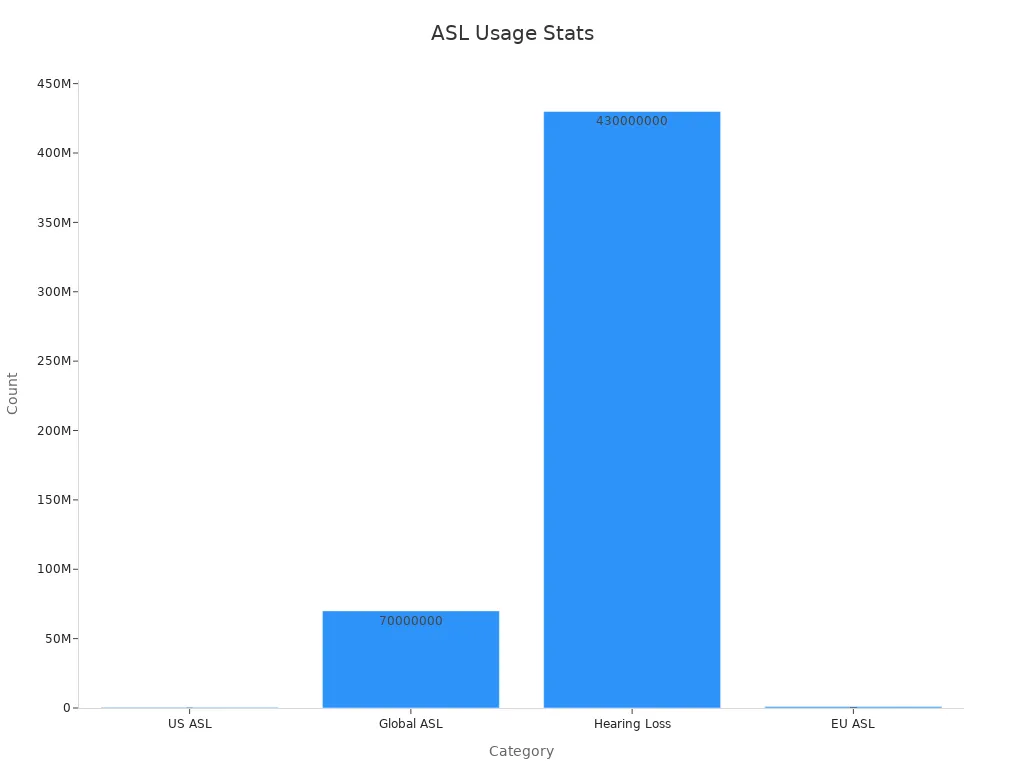
What Does ASL Mean Online and How Is It Used
You may have seen the term ASL online and wondered, what does asl mean? ASL can stand for "age, sex, location," a common question in online chats. It also means "American Sign Language," a rich language used by many Deaf and hard-of-hearing people. Knowing both meanings helps you communicate better and show respect in different online spaces.
If you are new to these terms, do not worry. You are in the right place to learn.
Key Takeaways
- ASL has two meanings. It stands for 'age, sex, location' in online chats. It also means 'American Sign Language.' Deaf people use this language every day.
- People type 'asl?' online to ask about you. They want to know your age, sex, and where you live. But giving out private details can be unsafe.
- American Sign Language is a real language. It has its own grammar rules. People use hand shapes, faces, and body moves to talk.
- There are many free websites to learn ASL. These sites help you understand Deaf culture too.
- Always think before you share things online. Be respectful when you use or talk about ASL.
What Does ASL Mean
Online Slang Meaning
When you see people ask "what does asl mean" in online chats, they often refer to the slang phrase "age, sex, location." This question became popular in early internet chatrooms. People used it as a quick way to get to know each other. You might see someone type "asl?" when they want to learn basic facts about you.
- ASL stands for "age, sex, location."
- People used it as an ice-breaker in instant messaging and chatrooms.
- You can still find it in casual chatting, gaming communities, social media, and dating apps.
- Some people view it as outdated or informal. It sometimes has a negative reputation because strangers may use it to ask for personal details.
- Social media profiles now show much of this information, so you do not see "asl?" as often as before.
Tip: If someone asks you "asl?" online, think carefully before sharing personal information. Protect your privacy and stay safe.
You may wonder, what does asl mean for you today? It still helps people introduce themselves quickly in informal online spaces, but you should use it with caution.
American Sign Language
You might also ask, what does asl mean outside of internet slang? ASL stands for American Sign Language. This is a complete language that Deaf and hard-of-hearing people use to communicate. ASL has its own grammar, structure, and rules. It is not just a way to spell English words with your hands.
Research shows that learning ASL early in life helps people develop strong language skills. For example, studies found that Deaf students who learned ASL before age six scored higher on language and reasoning tests. Students with higher ASL skills also did better in reading, English, and math. Early and fluent exposure to ASL supports both communication and academic success.
- Early exposure to ASL leads to better language and reasoning skills.
- Students with strong ASL skills often do better in school subjects like reading and math.
- ASL uses hand shapes, facial expressions, and body movements to share ideas.
Note: American Sign Language is more than a way to talk. It is a key part of Deaf culture and identity.
When you ask, what does asl mean, you see that it can connect people in online chats or help people communicate in a rich, visual language. Both meanings show how important it is to understand the context when you see "ASL" online.
ASL in Online Conversations

Usage in Chats and Social Media
You might see "ASL" in online chats or gaming groups. People sometimes use it to ask about your age, sex, and location. Other times, "ASL" means American Sign Language. Some people share ASL videos or GIFs online. Technology helps Deaf and hard-of-hearing people join online talks. For example, apps like Connect Deaf let you type in sign language. You can also send ASL videos in WhatsApp or Facebook Messenger.
| Evidence Type | Description |
|---|---|
| Quantitative Data | Over 500,000 people in the US use ASL as their main language. About 70 million use sign language worldwide. |
| Examples of Usage | Apps like Connect Deaf and ASM4Deaf help users share ASL videos and GIFs in social media chats. |
| Application Context | These tools support multiple sign languages and help make social media more inclusive. |

What you share online helps shape your identity. Many people use hashtags or join groups to meet others with the same interests. You might see people use ASL videos to tell stories or teach signs. Some join events or share their culture. Social media lets you try new ways to show who you are. But you should always think about what you post.
Tip: Before you join a group or chat, check if they allow ASL content or personal questions.
Etiquette and Safety
If someone asks "ASL?" in a chat, stop and think first. Sharing your age, sex, or location can risk your privacy. Experts say you should not give personal details to strangers online. If you want to talk about American Sign Language, share helpful tips or your own stories. Do not share private information.
- Never give your full name, address, or other private details in public chats.
- Use privacy settings to control who can see your posts and videos.
- Ask before you share someone else's ASL video or story.
- Follow the rules for each group or platform.
Note: Laws like the Americans with Disabilities Act (ADA) and Section 508 protect your right to accessible communication. These laws also set rules for privacy and sharing information.
When you follow good rules and protect your privacy, you help make online spaces safer. Always think before you share. Remind others to do the same.
ASL as a Language

Key Features of ASL
Some people think ASL is just English with hands. That is not true. ASL is its own language with special rules. It uses hand shapes, movements, and facial expressions. Body language is also important in ASL. The grammar in ASL is not the same as English. Sometimes, the order is subject-verb-object. Other times, it is object-subject-verb or topic-comment. Raising your eyebrows can show a topic or a question.
ASL has something called classifiers. These are handshapes that stand for objects or people. For example, a fist can mean a rock. A different handshape can mean an airplane. Classifiers move in space to show action. It is like telling a story with puppets. This helps show movement and relationships in a visual way.
Researchers found homesigners make their own grammar rules. They use things like plurals and agreement. This shows language structure can grow by itself. Studies show gestures can have grammar too. Pointing in different ways can show who does what. These facts prove ASL has a real system shaped by how it looks.
| Feature | Description |
|---|---|
| Grammar | Uses SVO and OSV word orders, topic-comment structures, and non-manual signals. |
| Morphology | Changes meaning by modifying signs, not by adding endings. |
| Classifiers | Handshapes that represent objects or people and show action in space. |
| Numeral Incorporation | Combines numbers with signs, like showing "three weeks" with one sign. |
Tip: When you learn ASL, watch faces and hands. Both are important for understanding signs.
Online ASL Resources
There are many online tools to help you learn ASL. Some sites have video dictionaries, like Handspeak and Signing Savvy. You can search for signs and watch how to do them. Learning sites like ASL University (Lifeprint), Start ASL, and The ASL App have lessons and quizzes. Some even have games and stories in ASL.
- Handspeak: Has videos and grammar tips.
- Signing Savvy: Lets you search for signs and see examples.
- ASL University (Lifeprint): Free lessons and notes about culture.
- Start ASL: Step-by-step courses for new learners.
- The ASL App: A phone app with video lessons.
ASL is more than just a way to talk. It is a big part of Deaf culture and identity. When you learn ASL, you join a group that values visual language. You help make the world better for everyone.
Related Slang and Abbreviations
Common Alternatives
You might see other versions of "ASL" in online chats. Some people use different abbreviations or add extra letters. These changes help make the question more specific or friendly. Here are some common alternatives:
-
A/S/L?
This is the same as "ASL?" but uses slashes. People type it to ask about your age, sex, and location in one quick message. -
ASLP
The "P" stands for "picture." When someone types "ASLP," they want to know your age, sex, location, and if you can share a picture. -
ASLR
The "R" means "race." This version asks for age, sex, location, and race. -
ASLF
The "F" stands for "favorite." Sometimes, people use this to ask about your favorite things, like music or movies, along with age, sex, and location.
Tip: If you see a new abbreviation, ask what it means before you answer. This helps you stay safe and understand the chat.
Other Online Terms
Online chats use many short forms and slang. You might see these terms when you talk to others:
| Abbreviation | Meaning | When People Use It |
|---|---|---|
| BRB | Be Right Back | When you need to leave for a bit |
| LOL | Laugh Out Loud | When you find something funny |
| DM | Direct Message | When you want to chat privately |
| IRL | In Real Life | When you talk about offline stuff |
| TTYL | Talk To You Later | When you end a conversation |
You can use these terms to chat faster and fit in with online groups. Always remember to check the meaning if you feel unsure. New slang appears often, so staying curious helps you keep up.
Note: Using the right slang can help you connect with others, but you should always protect your privacy and respect others in every chat.
You have learned what asl means in chats and as a language. Both meanings are important for good and respectful talk. Here is a simple checklist:
- Look at the situation before you answer "ASL?"
- Keep your private information safe online.
- Show respect for Deaf culture and their language.
Keep asking questions and use safe, friendly words when you talk online.
FAQ
What should you do if someone asks "ASL?" in a chat?
You should pause before you answer. Think about your privacy. Never share personal details with strangers. If you feel unsure, you can ignore the question or ask why they want to know.
Is American Sign Language the same as English?
No, ASL is a different language. It has its own grammar, rules, and signs. You use your hands, face, and body to communicate in ASL.
Can you learn ASL online for free?
Yes! Many websites and apps offer free ASL lessons. Try resources like ASL University, Handspeak, or Start ASL. You can watch videos and practice signs at your own pace.
Why is ASL important in Deaf culture?
ASL is more than a language. It connects people in the Deaf community. You show respect and understanding when you learn ASL. It helps you build friendships and support inclusion.
